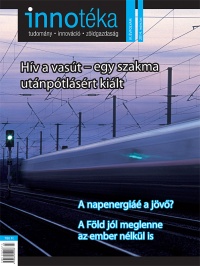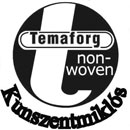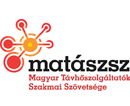Slope protection with three dimensional wool mesh
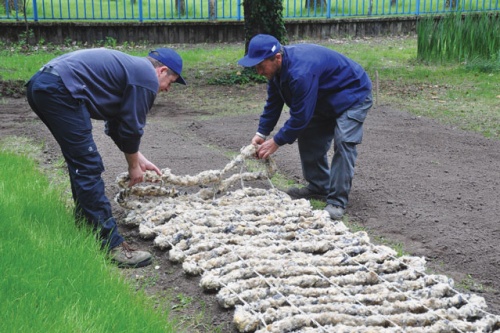 Mesh anchorage
Mesh anchorageThe company produces nonwoven materials with the spatial density between 40-1500 g/m2. The recycling of the waste and composite materials is significant similarly to the regular materials. The half of the manufactory’s production is sold abroad. One of their main product line is geotextiles (with CE marking), which technical textiles are made from polypropylene and polyester fibrous material, with needle felting and heat treating technology. These can be used in the construction industry, in civil engineering, at roof isolation, in the field of waste storage, road- and railroad construction.
In addition to their traditional products, they have developed a product that is suitable for covering and recultivating of rocky, clayey, soil not consisting, plain and sloping surfaces. The company, which is open to the use of innovative technologies, has examined the possibilities, on which raw material base, technological possibilities and machine background to build. In this knowledge it was decided to launch a new project to develop an innovative product, based on naturally degradable fibers, and other, also degradable components. It provides protection against erosion, promotes vegetation, completely degrades due to environmental effects and in the area no environmentally unsuitable material residue remains.
The development was carried out in accordance with the GINOP-2.1.2-8-1-4-16-2018-00386 project, called „Production technology development of a decomposing three-dimensional non-woven textile at the Temaforg Ltd.”.
In the first stage, they purchased a braiding line, which consists of a demolition and a braiding machine, and an arm punching machine. Thereafter were the basic and auxiliary materials for the subsequent production tests selected. According to the pre-determined standpoints, they were looking for environmentally friendly materials that are no longer usable or have limited use in other industries, and no ecological damage occurs after use or degradation. Furthermore which are on inland and on international markets also in big quantity procurable and their price is favourable for the development of the new product. It should have appropriate physical and mechanical characteristics, and in industrial environment -using the acquired production technology, can be economically processed. They were with hand samples modelled, analysed and the resulting raw material scale was used for further tests. The test of the selected materials and the first trials were carried out on the finished technological production line and at the same time the machine settings and the production technology were also developed. The range of products has been further narrowed to use only for the purpose suitable materials to the trials.
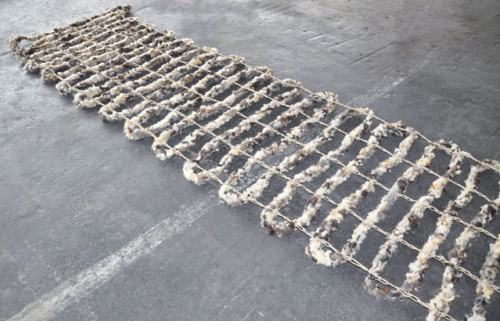 Manufactured good control
Manufactured good controlIn the second stage, mechanical, industrial production was examined; different types and numbers of products (1-4 guide wires) were produced from all available raw materials. At the sample material the product’s linear mass, the specific linear % per mass were examined, the diameter, the equability indicator were specified as well as volume index. With the demolition machine the sample’s tensile strength and the elongation at brake were also specified. By comparing the obtained results, a ranking was established among the possible raw materials; also the purchase price and the aspects of security of supply were already taken into account.
As a result of comparative studies of a raw material wool and cotton were selected, which were braided around 4 guided thread sisal, cotton, hemp, flax. For braiding cotton, hemp or flax yarn was chosen. Accordingly, from the above mentioned materials a rope has been produced, with 100-120 g/m2 linear mess, and 30-35 mm diameter.
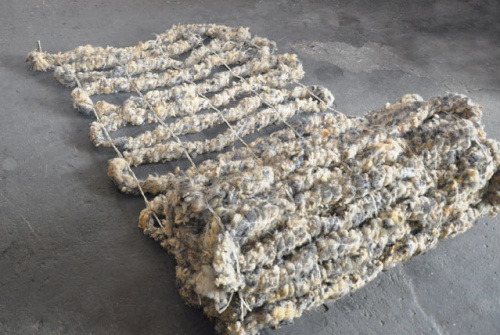 Preparation for shipment
Preparation for shipmentIn the next phase, the finalization of the production and machine technology occurred, and the goal was to make a three-dimensional finished product from the rope. In the last stage, from the ropes with a linear mass of 100-120 g/m2, a three-dimensional mesh structure was fabricated by an accordion-like spiral structure, in different sizes. To secure the spiral branches, sisal-, jute- and hemp- basic binder materials were used. The conditions and possibilities of economic and technological production were tested by the meshes with different sizes.
Real installations were performed to determine the most favourable production dimensions, also from the side of the customers. It was examined whether the size of the finished products is suitable for any machine installation. For manual installation the weight limits and mobility considerations points also came to the fore. The possibilities and limitations of the use on flat or sloping surfaces were examined, and the auxiliary technical conditions at the application were also determined. According to the result of countless installations and the customer reflections about the pilot plantations in different sizes, the 1×3 and 1×4 meters three-dimensional mesh structure were chosen. For rope production as a raw material primarily wool, as guided thread sisal, for braiding cotton yarn, and for the three-dimensional mesh structure hemp binders were chosen. Special additional devices have been developed for the implementation of the mesh structure, which, in addition to continuous quality, also ensure economical product fabrication.
Trial installations have shown that the three-dimensional product with the longitudinally and transversely junction can make the mesh endless. This is particularly advantageous for economical and safe recultivation of large areas and slopes.
With this development, the company succeed to expand its product range with a new, environmentally friendly, three-dimensional, degradable product.•



